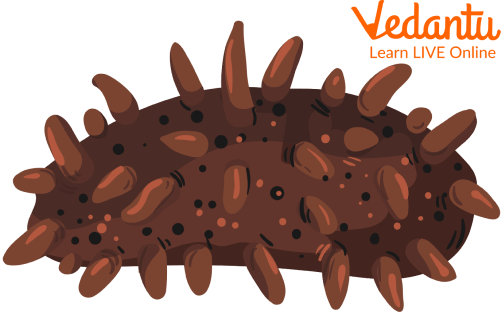




Sea Cucumber: Definition, Habitat, and Key Characteristics
Sea cucumbers are Echinoderms which are a type of invertebrate that can be found in all oceans. They mainly live in shallow water. However, some are also present in the deep ocean. Due to their cylindrical shape and the bumps all over their bodies, they are known as sea cucumbers. Take a look at the sea cucumber image below to get an idea about its appearance.

Sea Cucumber Images
Sea cucumbers come in roughly 1,200 different species or varieties. Echinoderms are creatures with hard, spiky skin. Sea urchins and sea stars are additional echinoderms.
To create a variety of goods, such as toothpaste, shampoo, and pharmaceuticals, sea cucumbers are gathered. People in China like to eat sea cucumbers. There has been a significant decline in sea cucumber populations worldwide as a result of the demand for bêche-de-mer. Here it will be clear what is a sea cucumber and how we can use sea cucumber as food.
Physical Features of Sea Cucumbers
Sea cucumbers are found in shallow water but sometimes they are found at depths of thousands of metres. Given below are the physical features of sea cucumbers.
Since sea cucumbers are invertebrates, they lack a backbone. The animals are between 0.4 and 8 inches (1 and 20 centimetres) thick and 0.75 inches to 6.5 feet (2 to 200 centimetres) long.
Five rows of tube feet are found on most species. Tube feet resemble miniature legs. Typically, sea cucumbers move quite slowly. Some creatures that live in the deep sea can swim.
The mouth of a sea cucumber is encircled by ten or more tentacles that are employed for eating or digging. They eat mud that is rich in nutrients or algae.
Inhalation and expulsion of waste products both occur through the anal orifice.
Many sea cucumbers can develop new internal organs after expelling old ones through the anus. Nobody is certain about the cause of this.

A Diver Holding a Sea Cucumber
Reproduction in Sea Cucumbers
Sea cucumbers have two methods of reproduction. The female can release millions of eggs into the ocean as one method. The male's sex cells then fertilize the eggs. The fertilised eggs are capable of self-development. The alternative method involves asexual reproduction. This implies that sea cucumbers can split in two and produce their own young.
Sea cucumbers use a variety of defence mechanisms. Some people exhale a gooey fluid that can trap or perplex an adversary. Other sea cucumbers create a poison that can harm small animals.
Sea Cucumber as Food
Although sea cucumbers can be eaten raw, fried, or pickled, they are most frequently added to dried recipes, where they will rehydrate and acquire their distinctive slimy texture.
Sea cucumber, like tofu, is bland but can take on the flavours of the food and seasonings it is cooked with. It is frequently paired with other seafood, meats, and spices, as well as traditional Chinese ingredients like winter melon, cabbage, and mushrooms, which is why it is frequently used in soups, stir-fries, and some braised meals.
Facts about Sea Cucumber
Sea cucumbers live on the ocean floor or benthic zone. The following are some of the sea cucumber facts:
The Holothuroidea subclass of echinoderms includes sea cucumbers. They are somewhat long and have leathery skin.
Sea cucumbers, like all echinoderms, have calcareous endoskeletons just below the skin, typically reduced to individual ossicles connected by connective tissue. These can occasionally be expanded into flattened plates to produce armour.
Sea cucumbers are ocean floor dwellers.
The majority of sea cucumbers scavenge.
Sea cucumbers come in roughly 1500 different species.
Sea cucumbers have a unique breathing system and strong predator defences. They are also sensitive to touch.
They are consumed by several people, especially the populations of China, Malaysia, Indonesia, Japan, Korea, etc.
There are more than 1200 species of sea cucumbers which are known to us.
Given below is a sea cucumber image.

Sea Cucumber
Summary
From the physical features and sea cucumber facts, we know that a long and cylindrical underwater creature is known as a sea cucumber. It features five double rows of tube feet running the length of its body in place of arms. The skin of the sea cucumber is covered in spines. Most are either brown, green, or black. Ten tentacles encircle its lips on all sides. The brain is absent from the sea cucumber. Far Eastern nations including Malaysia, China, Japan, Korea, and Indonesia prize sea cucumbers as a delicacy. We hope all important points related to sea cucumbers are clear to you. This article will give you all the details about sea cucumbers.
FAQs on What Is a Sea Cucumber?
1. How can we store sea cucumbers?
Although sea cucumbers can be eaten raw, fried, or pickled, they are most frequently added to dried recipes, where they will rehydrate and acquire their distinctive slimy texture. For up to three years, dried sea cucumber can be kept in its original packaging in a cold, dry location like the pantry. Frozen food should be stored in the original container in the freezer for up to 24 months. The refrigerator may hold frozen sea cucumber for two to three days once it has thawed there overnight.
2. What are the varieties of sea cucumbers?
Sea cucumbers come in a wide range of kinds, but the edible ones can be categorised into three groups: prickly sea cucumbers, bald sea cucumbers, and white teat sea cucumbers. The pricy kind of sea cucumber is elongated, black in colour, and has a spiny surface. Its crisp and slightly springy texture makes it highly regarded.
3. Where do you mostly find sea cucumbers?
Australia, Africa, and the Middle East are all home to sea cucumbers. Compared to the prickly sea cucumber, it has a rounded head and a plumper body.
4. Why can't you touch a sea cucumber?
We can’t touch a sea cucumber because when the Cuvierian tubules from sea cucumber venom come in contact with the eyes, it can cause irreversible blindness in people.









